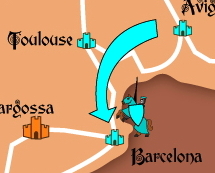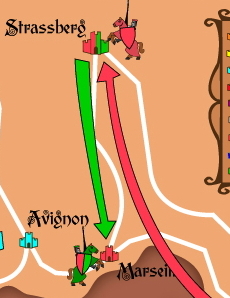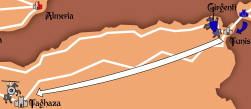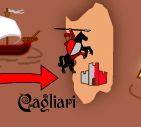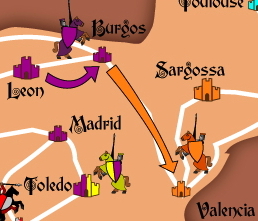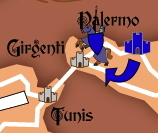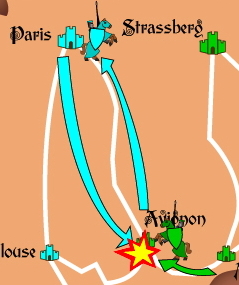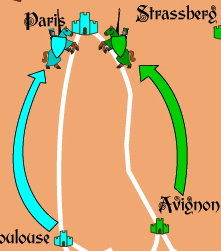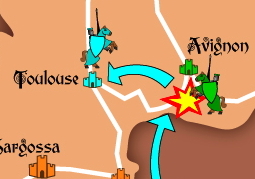When 1304 dawned over southern Europe and North Afrcia, many nations were weary of war. Spain had been ravaged. The wars pitting Leon against Aragon, and Castile against Leon and Granada, and finally Aragon against Granada brought the peasants in Iberia to the brink of revolt!
And so it was that as Aragon and Castile mustered for continued war against Leon, the peasants would not support them. In the north Don Juan Dangeroso of Aragon marched from Burgos and put the city of Leon under seige. After fighting a vicious siege all through spring, but failing to take the walls, the Aragonese supplies had run out. Foraging proved fruitless and the peasants refused to give up their goods bitterly in both Aragon and Leon. Because of this, Aragon could not muster the resolve needed to take the gates of Leon, having to constantly battle minor peasant revolts to stay supplied and also hold the seige. Thus, Leon did not fall, and the kingdom would remain independant in 1304.
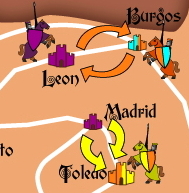
Leon does not fall!
To the south, Castile mustered what small army it could from the city folk of Toledo and marched north in attempt to reclaim Madrid. But like Aragon, even the small army of Castile could not remain supplied without much effort. After spring and summer had waned, the already small army of Castile had disolved and Madrid remained in the hands of the kingdom of Leon. And so, in spite of the actions of Roberto, king of Leon, the people of Spain put an end to the wars of the Christian kingdoms, and only Leon remained free of all the Iberian realms.
But as the wars of Iberia ground to a halt through 1304, the French did not arrive. Despite their promise to sack Leon along with Aragon, they failed to follow through. In the autumn of 1303 ibn al-Joeahmar forged an agreement with the French and Aragon: Granada would allow Don Juan free passage back to Aragon if both the French and Aragon agreed to sack Leon. They both agreed and Don Juan wintered in Sargossa. France's failure to arrive was nothing short of betrayal, but there was more than just betrayal in the making. Ibn al-Joeahmar heard of a French treachery before Black Jaques Shellac could spring his attack, and messengers were sent, ships dispatched, armies re-deployed, and battle made ready!
The French plot, as it was revelaed to al-Joeahmar, was to bring the kingdom of Naples and attack the island of Sardinia and capture the city of Cagliari from Granada! Ibn al-Joeahmar resolved to never again trust the French, especially kings names after the digestive excretions of unsavoury bugs! (Yes, shellac is bug poop, and you eat it!). Both the Spanish Leon and the French proved themselves without honour! Thus it was that planning and logistics were begun by both the French and Granada to make war for Cagliari!
Ibn al-Joeahmar learned that the French planned to invade Cagliari in the autumn, as it would take them spring and summer to muster their army, build their ships and coordinate with the kingdom of Naples to do the same! Two armies would invade, and whoever faced them would have to face two armies, not one!
A message was sent to Sicily, and Ibn al-Joeahmar forged a pact with the Sicilians: if they would come to Sardinia to battle the invaders then al-Joeahmar would pledge as a tributary to Sicily! And so it was that Sicily and Granada, like Naples and France, made ready to sail and make war over the tiny island of Sardinia!
On the dawn of autumn, just as the weather began the change, the armies set sail. Good winds and steady waves prevailed for all, except the kingdom of Naples. A storm caught a small flotilla of Naplese ships and dragged them down. Despite this, the army of Naples arrived in Sardinia relatively unharmed! And so the armies mustered and were ready for war!After much debate and tenuous diplomacy, the armies were deployed and ready for battle! The fight that ensued was a tense one. Both sides held their council, many move were monitored with precision and even accusations of cheating were made with offending nonchalance! Campaigns, and the extra consequences of losses really seem to make the ton of a game a little more tense I've found... Despite this however, it was quite the battle! The Naplese held the center firmly, repelling the bulk of the Granada and Sicilian forces, while the French battled over and lost a steep hill, while their entire force of mounted knights and warriors were held at bay by a single unit of skirmishers!

Cagliari falls to Naples!
Much blood was spilled and in the end, the Sicily-Granada alliance had lost. Sicily lost four elements while Granada had lost three. The Franco-Naples alliance didn't leave unscathed however, the French having lost three elements and the Naplese one. Thus it was that Sicily and Granada sailed for home as the autumn took hold of the land. However, the Franco-Naples victory opened a gap between the alliance, since possession of the city had still to be decided!
After much negotiation, and reasoned speculation, the French and Naplese were able to find a resolution without coming to blows themselves: Naples would take Cagliari since they dispatched the majority of the enemy during battle, and the French would sail back to Barcelona. And so it was that the campaigning season of 1304 ended, and so war the era of great wars in southern Europe and North Africa! And who would come out the victor? Despite their loss in Cagliari, the Sicily-Granada alliance proved it's strength, and in the end, Sicily held sway over all the lands in southern Europe and North Africa!
And so it ends! Eight months after it started, we decided to end it with a big battle, two on two game! I was quite happy with it, and overall very happy with how it went. Yes, there was a lot of small rules lawyering, and yes, I was blatantly accused of cheating, which offended my sensibilities greatly! I reacted in a much dramatized and offended way... It didn't help that my blood sugar levels were dangerously low... But I did have a great time! It was the best big battle game I had played to date, and it really added a narrative to the campaign itself. Fun stuff! I would do it again for sure.
In the end, Sicily roke out ahead and took the campaign! Really, I think it was between Naples and Sicily after the Spanish were broken by war. Yes, the French were a force in the end, but had trouble getting momentum in the early part of the campaign, which held them back. Sicily and Naples however suffered few or no defeats, and regained everything they lost or lost nothing at all! I think Sicily pulled ahead because of its battle prowess really, being one of the top battle prestige scorers.
I would like to thank everyone that took part and helped weave the narrative that was the 'Cry Havoc!' campaign! I had a lot of fun, and I appreciated everyone's participation! Overall, everyone put a lot of effort into making it out for the games, painting their armies, developing their tactics, and even role playing... Well, almost everyone... There was one player who after an entire year (that is, a year in real-time) failed to paint their army and fielded a primed army even in the last battle! Yes, Mark, I am giving you a hard time :) It was a great time, and I'm happy with how it ended up! For the nitty gritty final standings, please see the table below.













